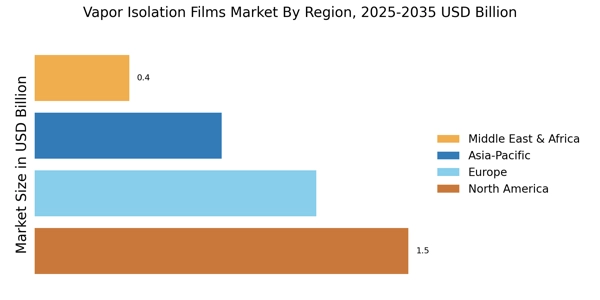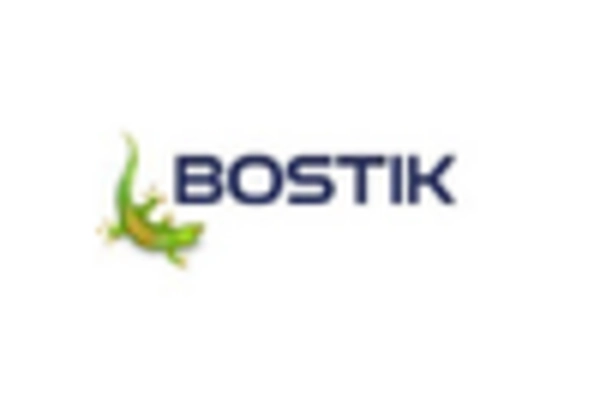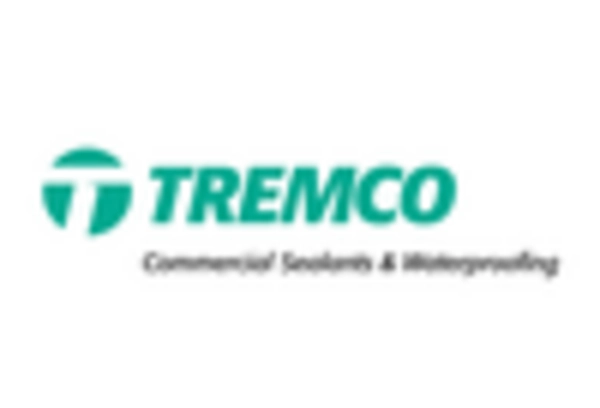Increased Construction Activities
The resurgence of construction activities across various sectors, including residential, commercial, and industrial, is driving the Vapor Isolation Films Market. As urbanization accelerates, the need for new buildings and infrastructure is becoming more pronounced. This surge in construction is accompanied by a heightened awareness of the importance of moisture control and energy efficiency, which vapor isolation films provide. Recent statistics indicate that construction spending has seen a steady increase, with projections suggesting a growth rate of around 5% annually. Consequently, the demand for vapor isolation films is expected to rise in tandem with these construction activities, positioning the Vapor Isolation Films Market favorably for future expansion.
Rising Demand for Energy Efficiency
The increasing emphasis on energy efficiency in construction and manufacturing sectors appears to be a primary driver for the Vapor Isolation Films Market. As energy costs continue to rise, builders and manufacturers are seeking materials that can enhance insulation and reduce energy loss. Vapor isolation films play a crucial role in this context, as they help maintain thermal performance and prevent moisture intrusion. According to recent data, the demand for energy-efficient building materials is projected to grow at a compound annual growth rate of approximately 7% over the next five years. This trend suggests that the Vapor Isolation Films Market is likely to experience substantial growth as more stakeholders prioritize energy conservation in their projects.
Growing Awareness of Indoor Air Quality
The increasing awareness of indoor air quality (IAQ) is emerging as a significant driver for the Vapor Isolation Films Market. As consumers and businesses alike become more conscious of the health implications associated with poor IAQ, the demand for materials that can mitigate moisture and prevent mold growth is rising. Vapor isolation films are recognized for their ability to enhance IAQ by controlling humidity levels within buildings. Recent surveys indicate that a substantial percentage of homeowners prioritize IAQ when making construction decisions. This trend suggests that the Vapor Isolation Films Market may see heightened demand as stakeholders seek solutions that promote healthier living and working environments.
Regulatory Standards and Building Codes
The evolving landscape of regulatory standards and building codes is likely to impact the Vapor Isolation Films Market positively. Governments and regulatory bodies are increasingly implementing stringent guidelines aimed at improving energy efficiency and moisture control in buildings. Compliance with these regulations often necessitates the use of vapor isolation films, which are essential for meeting performance criteria. Recent legislative changes in various regions have mandated the incorporation of advanced moisture control solutions in new constructions. This regulatory push is expected to drive demand for vapor isolation films, as builders and manufacturers strive to adhere to these standards, thereby fostering growth within the Vapor Isolation Films Market.
Technological Innovations in Material Science
Technological advancements in material science are significantly influencing the Vapor Isolation Films Market. Innovations such as the development of advanced polymer blends and nanotechnology are enhancing the performance characteristics of vapor isolation films. These innovations not only improve moisture resistance but also contribute to lighter and more durable products. As manufacturers continue to invest in research and development, the introduction of high-performance vapor isolation films is likely to attract a broader customer base. Market data suggests that the segment of high-performance materials is expected to grow by approximately 6% annually, indicating a robust future for the Vapor Isolation Films Market as it adapts to these technological changes.


















Leave a Comment